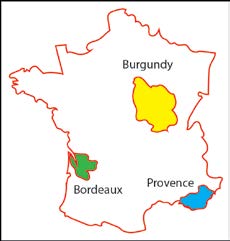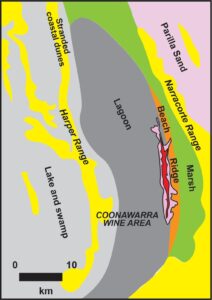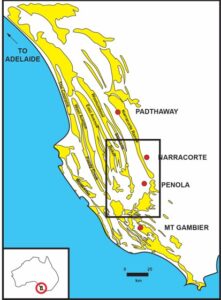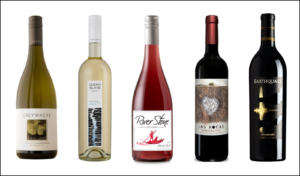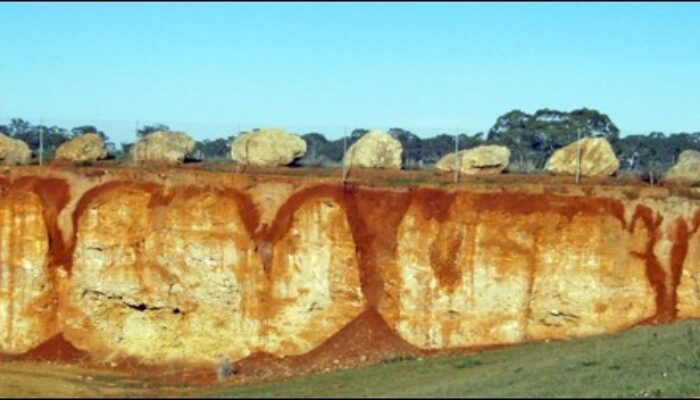
I am sure that there are many geologists who take a keen interest in wine, and not just in drinking it. Explaining the vast diversity of quality, flavours and aromas is no simple task, and what fascinates me is the relative role of the geology, and the associated soils, in determining which vineyards are winners and losers. Many factors will influence the character of the wine, generally summarized under the French term “terroir”.
What is terroir? The term was developed in France in the late 1960s to encompass the totality of the setting, or the “sense of place”, in which the grapes grow. The term has some almost mystical connotations, but includes the climate and weather, the soils and geology, as well as the slope and aspect (direction in which the slope faces). All of these characteristics are thought to have a significant influence on the flavour of whichever grape species has been chosen for cultivation. After harvesting, the processes used by the grower to transform the grapes into wine will have a key influence on the flavour, and the wine will also change character through maturation after bottling.
The impact of geology and soil
So how much influence does the geology have on the final product, compared to the climate? This topic was examined by James E. Wilson (a retired petroleum geologist) in 1998, in his book “The role of Geology, Climate and Culture in the making of French Wines”, and revisited in a series of articles by Simon Haynes of Calgary. Obviously a significant area of land is affected by broadly similar weather patterns, so the disparity in the quality of wines produced from adjacent vineyards, often at the same elevation and slope orientation, cannot be explained by differences in climate alone. This shifts the focus onto the geology and soil as key influences on the grape character.
The chemical analysis of wines confirms that the associated flavours are due to nutrient elements (typically metallic cations) and only distantly related to geological minerals, which are complex crystalline compounds (Maltman 2013). Hence the chemical composition of the rocks will not directly influence the grapes, particularly as the actual concentrations of mineral elements are typically miniscule, in part because they are relatively insoluble. Almost all minerals are also flavourless, with the exception of halite, and our mouths are unable to taste them. They are also lacking in aroma, with a few unpleasant exceptions, such as sulphur. So it is clearly not the mineral composition of the rocks that affect the taste, but must be something else.
Geology directly affects the soil, in that soils form from the breakdown of bedrocks over time. It is suggested that a typical soil forms at around an inch every thousand years. Immature soils are not layered, and are little more than gravels overlying bedrock, but mature soils may be stratified with surficial organic debris, topsoil and gravelly subsoil. Once the soil has formed it will affect the vines in two significant ways: firstly the level of nutrients in the soil will nourish the vines to a certain degree. More importantly, the soil and the underlying weathered bedrock will act as a conduit, inhibiting or enhancing the flow of groundwater, as well as potentially acting as a reservoir for water to replenish the vine through its root system.
Grapes respond to both feast and famine; hardship in the form of arid soils will usually lead to smaller grapes with more concentrated flavours. However yields will consequentially be much lower in such environments. The presence of water, stored in fractures in the bedrock near the surface, may provide vines with a longer growing season. However in areas of thicker, porous soils, the roots of vines may have to extend more than 50 metres into the subsurface in the search for water, meaning that a great deal of photosynthetic energy may be expended. This may in turn adversely affect the quality of the grapes on the vine. In very fertile, damp soils, the grapes may become “flabby”, with softer flesh and more dilute flavours.
Finally geology has a very obvious impact on the topography. Igneous and metamorphic rocks may weather to very rugged terrains, while softer (usually younger) sediments may lead to very flat, poorly drained areas, where vines will grow less successfully. The geology will also affect the degree and aspect of the slope. Very steep slopes drain effectively, but may lead to arid environments, with too little available water for the vines to suck up. Hence there are several ways in which the geology can impact eventual wine quality, and the right balance between adversity and plenty is needed to create the perfect wine.
A flavourful case study
Working with a sommelier from the COOP, we recently put together a wine tasting event that explored a variety of terroirs, and the potential impact of the geology on the various wines offered for sampling. A mixed audience of geologists and wine fanciers were in attendance to evaluate the relative contributions of climate and geology. Below I have selected some of the chosen wines, in order to highlight the geological contribution to their character.
First up was a Sauvignon blanc from the Marlborough region of New Zealand. These dry, white wines are renowned for their extremely fruity flavours, which may come close to overpowering the wine. Most of the vineyards are located on older river terraces, which may feature a fine grained, river borne (silts and muds) or windblown (loess) component, in addition to poorly sorted river pebbles. The river gravels are often only a couple of metres thick, underlain by metamorphosed bedrock, but may reach 30 m in thickness, when they will require drip irrigation. These cannot really be described as soils.
This geology is little different to the geology of the Loire Valley, where some of the world’s great sauvignon blancs (Sancerre, for example) are grown. However in France they are dry and “flinty” (a term relating to the acid hints in the wine only), rather than exceptionally fruity in character. Considerable scientific study of the Antipodean white wines (how would you fancy a PhD. looking at the geology of wine?) indicates that the reason for this fruitiness is the presence of thiols, chemicals that impart the classic kiwi and peach notes to the wine. The thiol concentrations are enhanced by machine harvesting (which presumably bruises the grapes), by the presence of unique yeasts (thought to relate to the very high UV levels, around 30% above the norm) and by higher than usual temperature fluctuations. Hence the geology apparently plays less of a role than climate in determining the character of this wine, acting mainly as a conduit.
A fascinating comparison between a South African Chardonnay from Stellenbosch and a Chablis from Burgundy demonstrated that these very similar grapes produced more acidic notes when planted on French gravel scree slopes derived from weathering of Jurassic limestones, with water trapped by Kimmeridgian clays. In contrast the South African soils have been forming for around 65 million years, and are very depleted in minerals and nutrients. Lime and phosphate have to be added to the acid, granitic soils, and the chardonnay wine is softer and more “middle of the road” as a result of the additives.
Rosés are Red
Provence is considered as the spiritual home of Rosé wines, and exhibits a striking spectrum of these wines ranging from pale pinks with a delicate taste, through to bold, almost ruby wines with a strong berry component. The reason is almost certainly the contrast between the arid, Cretaceous limestone soils, and the weathering products of the ancient crystalline massifs to the East. The grapes utilized include tight bunches of the tiny, strongly flavoured cinsault, which can be eaten from the vine.
Turning to the reds, the Malbecs of Argentina have a huge range in quality and taste. This relates directly to the geology, with a mix of outcropping volcanics and limestones, as well as alluvial gravels and silts. Such a diverse “rock garden” may be encountered at a single vineyard. The winemaker typically has to dig a series of pits across his property in order to evaluate where to plant the vines, and blending is employed to smooth out the localized vagaries in quality.
Next we chose the Priorat region of NE Spain for its unique terroir. The geology is striking, with very rugged topography and exceptionally stony soils. Shards of dark grey, Carboniferous slate spall from the underlying bedrock, and form a poor soil termed as “llicorella” in the Catalan language. Associated mica in the top 50 cm, eroded from volcanic rocks, traps water beneath it. The yields are very low, with the Garnacha vines basically growing on weathered bedrock, their roots penetrating deeply in their search for water, but the flavours are intense in what is one of the country’s best and most expensive wines.
Classic wines on display
Bordeaux is justifiably one of the world’s most famous wine growing regions. The landscape and geology are very variable, meaning that different wines flourish in different settings. Vineyards southwest of the Gironde River are planted on poorly sorted, glacial derived, river terraces, the best wines (like Margaux and Medoc) harvested from terraces around 700,000 to a million years in age. The other side of the river includes St. Emilion, grown on Tertiary limestones, and Pomerol, also grown on river terrace gravels. The gravels host small, dark grapes, which are stressed and therefore rich in flavour, while the limestone related wines are softer and easy drinking.
Our final wine region is located around the town of Coonawarra, some 400 km south of Adelaide in South Australia. This area produces one of the world’s great Cabernet sauvignon wines, grown on terra rosa soils. These soils comprise insoluble red clays produced by the karstic weathering of limestone, colored by iron oxides preserved above the water table. The clay allows surprisingly good drainage, in an area with a maritime climate similar to the Bordeaux region. The wines are full of plum and blackcurrant notes.
The terroir covers a narrow belt around 20 km long and only 2 km wide, located on a limestone ridge, located between two of a series of subparallel dune fields. The Coonawarra red soils formed just to the west of the beach rocks, and overlie rocks deposited on the edge of a lagoon. Using oil exploration methodology, one might hope to use the sweet spot at Coonawarra as a potential analogue for other terra rosa deposits between other dune fields. However this is a classic example of where a simple exploration play seems to work only once, although work continues to try and identify other areas where similarly spectacular wines could be grown.
- Geological sketch map of Coonawarra wine region (www.glug.com.au).
- Map of Pleistocene dunes around Coonawarra (after http://sahistoryhub.com.au)
It’s all in the plumbing
In conclusion, geology and soils are critical in helping to develop flavours of grapes on the vine. However it is not the associated minerals that lead to the flavours, but rather the porosity and permeability of the soils. The soils act like a hydroponic tank, water typically running through a framework of gravels beneath the surface, with an underlying storage medium made up of fractured bedrock. The geology also affects the nutrient levels in the soil, which may help or hinder vine growth, as well as controlling the topography of the vineyard. However when someone starts telling you that they can “taste the minerality”, you will know better!
STOP PRESS!!!!
A new study from the University of Geneva used AI to analyse the chemical composition of 80 red wines from Bordeaux. The algorithm, based on chromatographs, correctly identified the chateau of origin 100% of the time. It also guessed the year around 50% of the time. The work provides evidence that geography, climate, microbes and wine making practices AKA terroir, give wine a unique flavour (New Scientist 16th December 2023)





